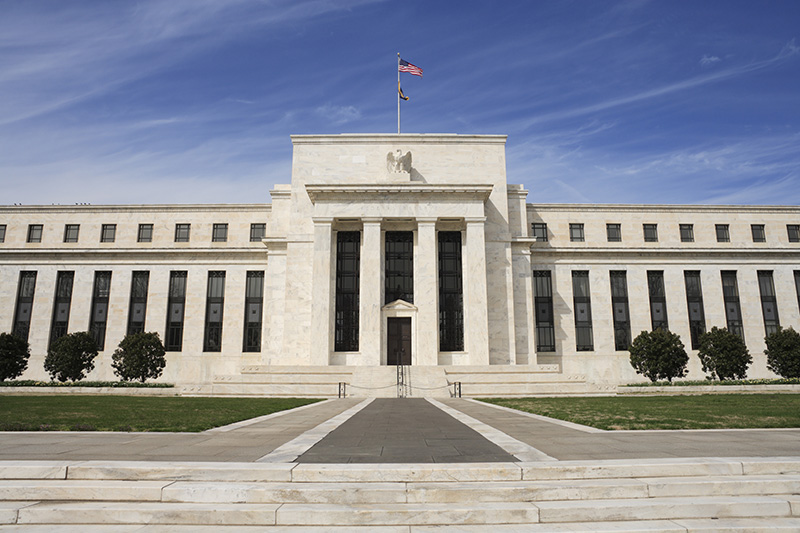(Bloomberg) -- Federal Reserve policy makers are discovering they likely need to shift into an even lower gear than in recent history if they are to speed up the U.S. economy.
Chairman Jerome Powell and colleagues last week estimated that the so-called neutral interest rate -- the level which neither stimulates nor restricts growth -- now sits around 2.5%, down from 2.75% in March and as high as 4% in 2014.
That means the Fed’s current benchmark of 2.25%-2.5% is unlikely to provide the power policy makers once assumed it would, leaving eight of them anticipating they will have to reduce rates this year amid growing risks to the economic outlook.
“This is really important,” said Torsten Slok, chief economist at Deutsche Bank Securities, who expects a rate cut in July. “For many years, the Fed has been arguing that monetary policy was easy and accommodative and supporting growth and inflation. After a decade of easy monetary policy, the Fed has decided that policy is no longer stimulative.”
Reasons listed for the lower neutral rate include ongoing fallout from the financial crisis, weaker productivity, continued slackness in the labor market and an aging population, which when combined leave the economy structurally weaker and so more vulnerable to rate hikes.
The upshot is the Fed may have to lower rates if it wants to boost expansion to offset global headwinds, including slow global growth and trade disruptions from President Donald Trump’s tariff battles.
Powell will give his view of policy in a speech on Tuesday to the Council on Foreign Relations in New York.
Futures Contracts
Fed funds futures contracts are pricing in at least a 25-basis-point cut in July, with roughly 44% chance of a 50 basis-point cut. Those expectations for a steeper drop in the policy rate have grown in the days since Powell signaled a willingness to act swiftly “as needed” to protect the economy.
“They have come to the conclusion that growth is slowed by productivity and demographic factors that predate the Great Recession and that are not reversing soon,” said Jonathan Wright, a Johns Hopkins University economics professor and a former Fed researcher.
Trump has targeted U.S. growth of 3% or more, a goal met last year because of fiscal stimulus including a $1.5 trillion tax overhaul. Kevin Hassett, outgoing chairman of Trump’s council of economic advisers, reiterated earlier this month he still expects 3% growth this year. “I’m not trimming it back,” he said June 3.
Forecast Shift
Fed officials didn’t explain their reasoning in changing the forecasts in the Summary of Economic Projections. While some including Powell have said they hope tax and fiscal policies will boost productivity, their lowering of the neutral rate is a concession they are not expecting that to be sustained. They estimate long-term growth at 1.8% to 2%.
“There was never going to be a big pickup in growth,” said Brad DeLong, an economist at University of California at Berkeley, who worked in the Treasury Department in the 1990s with Lawrence Summers, and like Summers has cautioned growth is in a period of “secular stagnation.” DeLong cites low inflation, high savings and risk aversion by borrowers. “It is not a surprise.”
Estimates of neutral -- sometimes called R-star -- have helped to guide Fed policy for years as a loose benchmark that didn’t get too much attention. Powell raised interest in the theoretical rate last October when he allowed that rates were “a long way from neutral,” implying many hikes to get there. He backtracked a month later by saying rates were just below a range of estimates of neutral.
The Fed’s target rate has never peaked at such a low level, rising to more than 5% before the last two recessions. Rates averaged 4.8% in the 20 years ended in 2007.
“Low neutral interest rates are very real, and they’re here to stay,” New York Fed President John Williams (NYSE:WMB), a leading researcher of the neutral rate, said in a speech in June. He cited low productivity, slower population growth and a decline in demand for savings.
Williams and two Fed colleagues, Kathryn Holston and Thomas Laubach, have used economic data in a model estimating neutral, at 0.42% as of the first quarter, implying a rate of about 2% or so, when inflation is included. That compares to rates of more than 5% in in the 1960s and 3.5% as recently as the late 1990s.
While estimates of long-term productivity have been unreliable, and some economists point to artificial intelligence and machine learning as potentially raising the level in the future, an aging population makes it unlikely there will be a big pickup in labor force growth. The national median age rose to 38.2 years last year, according to newly released data from the U.S. Census Bureau, while the number of births fell to the lowest level in 32 years.
Carl Riccadonna, chief U.S. economist at Bloomberg Economics, said the lower neutral rate is “inextricably linked” to declines in estimates of full employment as the U.S. labor market continues to tighten without appearing to spark much inflation.
“The Fed is eating humble pie, which is welcome news,” said Diane Swonk, chief economist at accounting firm Grant Thornton LLP. “They are shifting with reality as opposed to holding onto old dogma.
